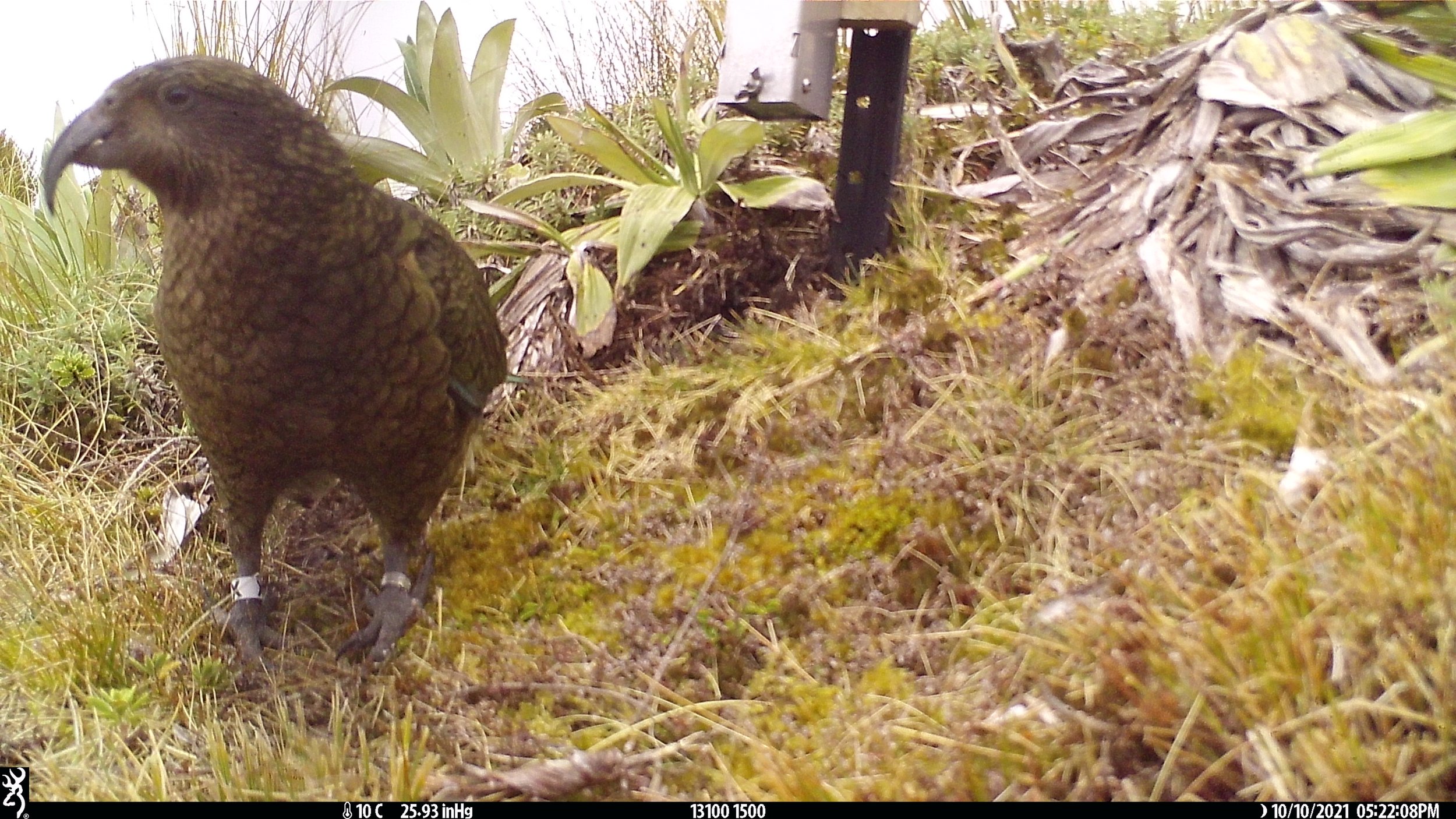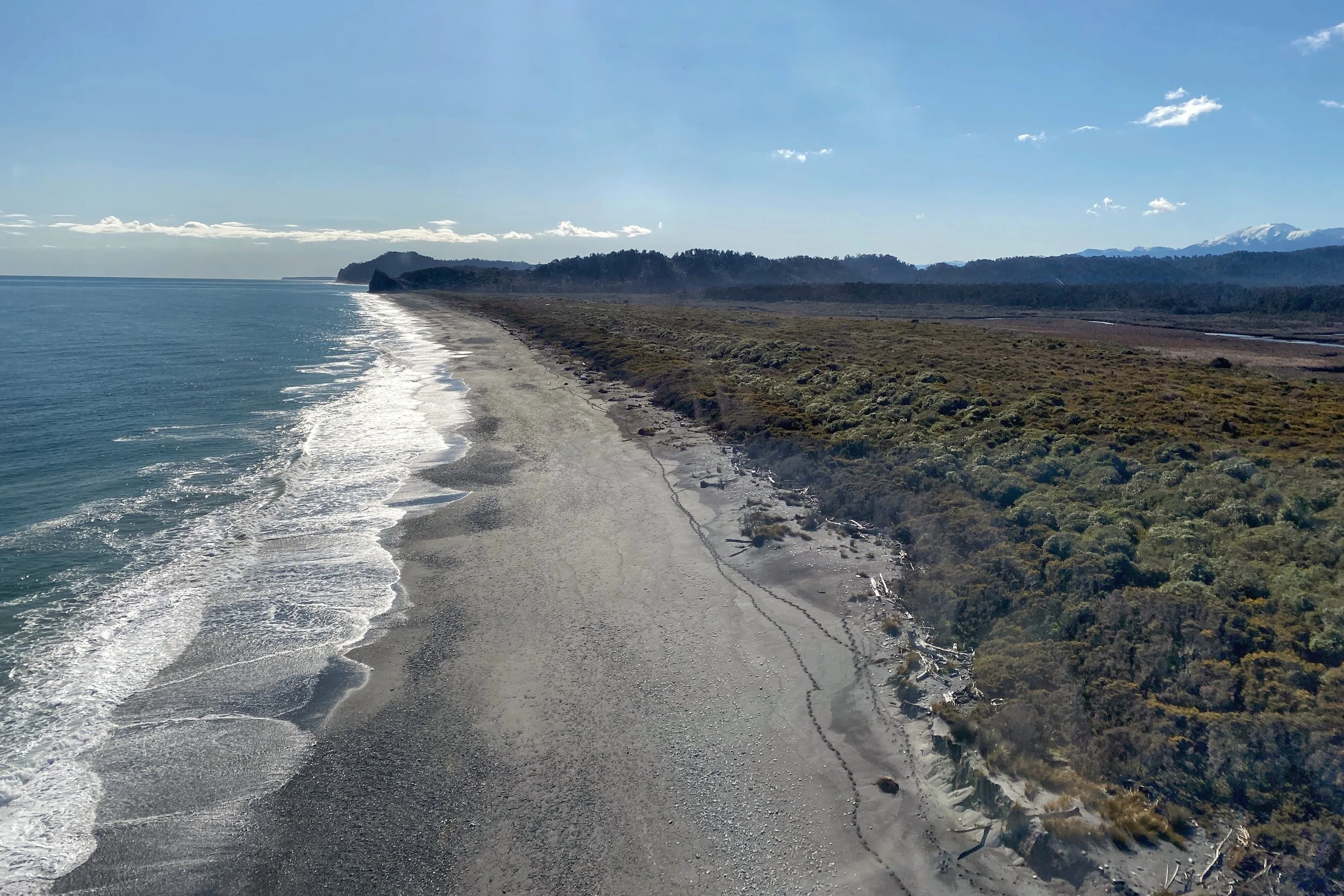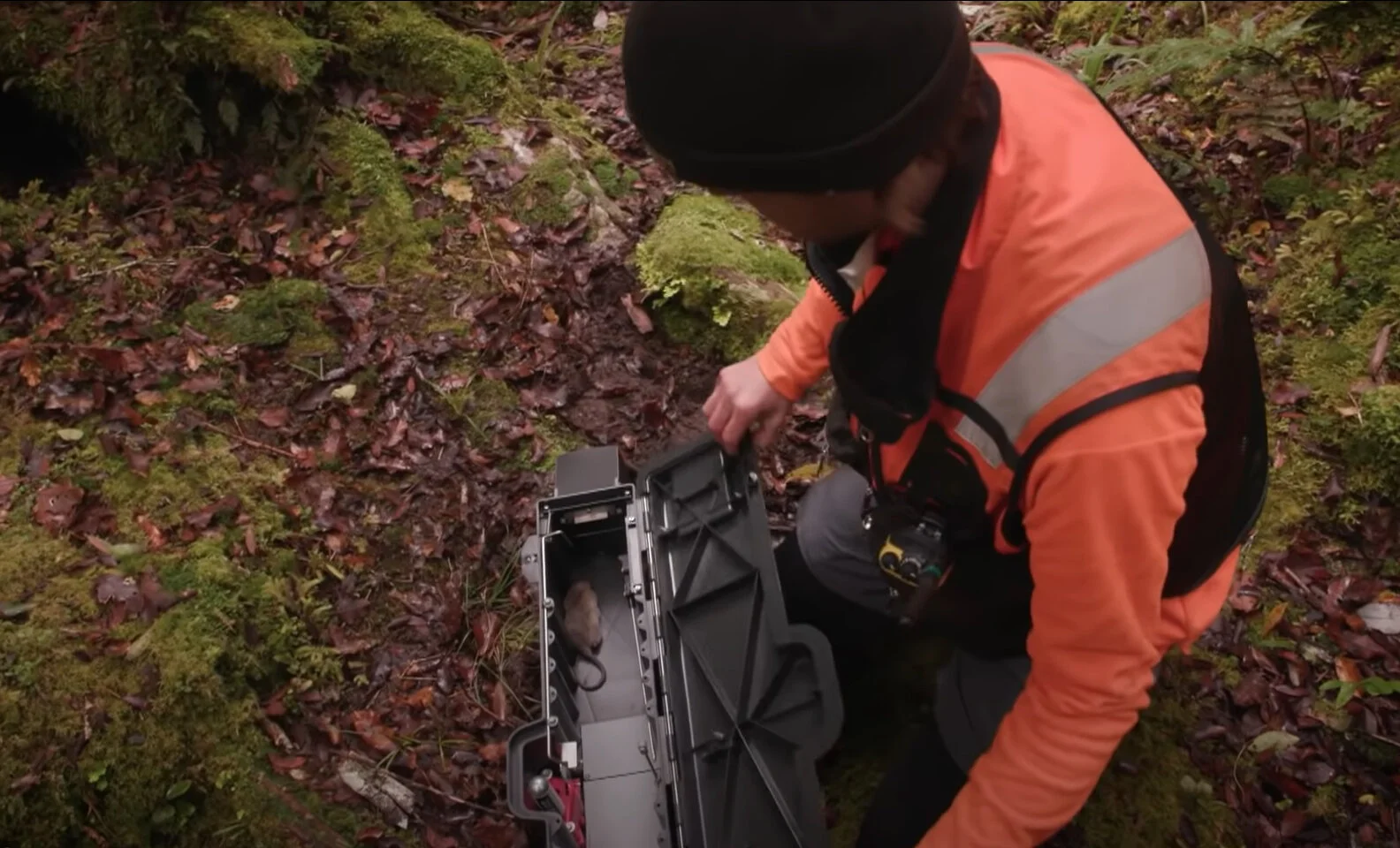In December 2020 we reported that the number of native birds in the Perth River Valley was beginning to recover due to the removal of predators over the previous 20 months. This work is part of the Predator Free South Westland project.
Since then, we have continued to see positive signs of native bird recovery. An insight into their recovery is enabled by the network of 142 lured trail cameras in the Perth River Valley that are deployed to detect possums (Trichosurus vulpecula), ship rats (Rattus rattus) and stoats (Mustela erminea). We retrieve the data from each camera every 4 to 6 weeks, and then plot and analyse it. In the almost 3 years that the cameras have been out we have amassed over 2.5 million images!
Each blue dot shows the location of a trail camera in the Perth River Valley. Each camera is set up in front of lure.
A rat investigates a MotoLure (an automated lure dispenser), March 2021
The predator detection data provides vital information about the number and extent of predators, which helps us to plan how to respond in order to eliminate them. The camera network also regularly detects native birds. These incidental detections also provide a useful indication of how well native species are responding in the absence of predators.
In October 2020 we analysed almost two years’ worth of native bird detections from this network. In January 2022, just over a year later, we once again analysed the proportion of cameras that detected native birds per month, over time.
Please note, the detection network is set up to detect our target species/predators, not native birds. The native birds detected are incidental, and are mainly species that spend time or feed on the ground. Species that naturally occur at low densities, or are primarily arboreal or waterfowl are less likely to encounter one of the cameras.
Incidental detections can provide an indication of the status of native birds in the valley; which for many species, reflects how their populations are responding in the absence of predators. In this update we focus on three species that are regularly detected across the network, from the valley floor to the alpine tops. These species are kea (Nestor notablis), kakaruai/South Island robin (Petroica australis australis), and ngirungiru /South Island tomtit (Petroica macrocephala). The detection rates per month for these species are shown on the following trend graph.
Detections across the Perth River valley trail camera network of kea, kakaruai and ngirungiru from March 2019 - January 2022
We assume that regularly recorded native species detections also reflect their population trends (just as we do for the predator population trends we analyse from trail camera data).
Some common features of the detection data for of the three species are:
The number of detections fluctuate over each year, peaking in summer with new fledglings, and dipping in winter/spring as the birds are nesting
For all three species, detection rates in the month of March have at least doubled between before we undertook predator removal in 2019 and two years later in 2021.
Kea
A kea caught on trail camera, October 2021
The local kea population in the Perth River Valley has benefited from previous predator management programmes and local kea experts estimated there were between 75-100 birds in the Valley before we started working there.
The effects of predation on kea and their nesting success are well researched. We know that when predators are managed with well-timed aerial 1080, more than 70% of kea nests are successful with at least one chick surviving. Without intervention only 40% of nests succeed and this drops to less than 10% of nests when there is a stoat plague (Kemp et al., 2018).
Kea detection rates fluctuate with the seasons, with higher activity in forests (where most of the trail cameras are) over winter, and above the treeline over summer. Despite that, kea detection rates are generally trending upwards.
Detections of kea increased from 8% in March 2019 (i.e. before predator removal began) to 15% in March 2021.
Some of the fluctuation in kea detections could also be due to a bumper breeding season in 2019, after which the fledglings then dispersed to other parts of the backcountry. To put it more technically, there was a “double-clutch” event in 2019 (i.e. kea nested twice, resulting in a higher-than-normal number of chicks), with the result that the local population appeared to increase substantially. That summer (i.e. 2019/20), our field rangers noted seeing fledglings of two different sizes in the Perth River valley. And then, in early 2021, a team monitoring and banding kea noticed a high number of juvenile kea in the adjacent Whataroa-Butler valley. It is possible that this valley may now be home to many of the birds that originally began their lives in the Perth River Valley.
Kakaruai/South Island robin
Kakaruai/South Island robin are sensitive to predation (Schadewinkel et al., 2014). Research has shown the nesting success of these at-risk birds significantly improves in the absence of predators, and we should be able to start seeing a difference 1-3 years after a predator operation (van Heezik et al., 2020).
Detections of robins increased from 5% in March 2019 (before predator removal began) to 11% in March 2021.
A kakaruai in front of a lure, May 2021
Ngirungiru /South Island tomtit
Of the three species we’ve focused on for this update the ngirungiru has had the most dramatic upward trend in detections.
Even taking into account seasonal fluctuations, ngirungiru have had an increase in detections-from 22% of the camera network in March 2019 (before predator removal began) to 55% in March 2021.
A ngirungiru, September 2021
However, over time we actually may see fewer ngirungiru due to competition with other native species. Recent research suggests that as the numbers of kakaruai grow, they may begin to displace the ngirungiru, and we may see a natural reduction in their numbers (Miskelly et al., 2021).
Other Native Birds
Yellow-crowned kākāriki continue to be regularly seen and heard, and are even beginning to feed on the ground in front of some of the cameras.
A kākāriki beside a MotoLure, June 2021, and a pair of kākāriki recorded August 2021
It’s particularly exciting to be seeing and hearing kākāriki, as their presence is often a good natural indicator of the overall health of a forest or ecosystem (McLennan, 2017).
In August 2019, we began sighting kākā in the Perth River Valley. While we have had more regular kākā sightings from the field team over time, camera detections have been sporadic; most likely due to their slow breeding cycle (Powlesland et al., 2009), and apparently low numbers pre-operation.
Kererū (Hemiphaga novaeseelandiae) continue to pop up in camera detections; although this is sporadic as they don’t often forage on the ground. We previously reported seeing flocks of up to 30 kererū in the skies—field team members have now even seen flocks of up to 80 birds!
A kererū on the sunny forest floor by a MotoLure, February 2021
Whio do not often show up on our detection cameras because very few cameras are located alongside waterways, which are the natural habitat of whio. That’s to prevent cameras from being washed away in floods. We have, however, continued to see adults and chicks each year in the Perth River Valley.
We also reported on several other native bird species in December 2020, which the field team continue to see and hear; e.g. korimako/bellbird (Anthornis melanura), tauhou/silvereye (Zosterops lateralis), kārearea /New Zealand falcon (Falco novaeseelandiae), ruru/morepork (Ninox novaeseelandiae), and seemingly endless tūī (Prosthemadera novaeseelandiae).
These incidental and anecdotal detections are a very good indicator that native birds in the Perth River Valley are continuing to recover and that predator freedom has had a positive effect on their populations.
“The bird life on my recent trip into the backcountry was certainly some of the best I have experienced, particularly in the Perth valley from Nolans hut. It’s up there with what I saw on the southern end of Rakiura, and in the Landsborough valley. We spotted a couple of groups of kea, but most noticeable was the kereru; lots and lots of them! Congratulations and keep up the good work.”
Acknowledgements
Thank you to Matt Hickson of the Department of Conservation for a review of an earlier draft of this update.
References
Kemp, J. R., Mosen, C. C., Elliott, G. P., & Hunter, C. M. (2018). Effects of the aerial application of 1080 to control pest mammals on kea reproductive success. New Zealand Journal of Ecology, 42(2), 158–168.
McLennan, J. (2017). The Cape to City Programme: baseline bird counts in treatment and non-treatment areas. A Report Prepared by John A McLennan Environmental Services Ltd, Havelock North, for the Cape to City Governance Group.
Miskelly, C. M., Greene, T. C., McMurtrie, P. G., Morrison, K., Taylor, G. A., Tennyson, A. J. D., & Thomas, B. W. (2021). Species turnover in forest bird communities on Fiordland islands following predator eradications. New Zealand Journal of Ecology, 45(2), 1–15.
Powlesland, R. G., Greene, T. C., Dilks, P. J., Moorhouse, R. J., Moran, L. R., Taylor, G., Jones, A., Wills, D. E., August, C. K., & August, A. C. L. (2009). Breeding biology of the New Zealand kaka (Nestor meridionalis)(Psittacidae, Nestorinae). Notornis, 56, 11–33.
Schadewinkel, R. B., Senior, A. M., Wilson, D. J., & Jamieson, I. G. (2014). Effects on South Island robins (Petroica australis) from pest control using aerially applied 1080 poison. New Zealand Journal of Ecology, 315–321.
van Heezik, Y., Ray, S. M., Jamieson, I. G., Allen, O., & Schadewinkel, R. (2020). Impacts of aerial 1080 predator control on nest success and adult survival of South Island robins. New Zealand Journal of Ecology, 44(2), 1–11.




















